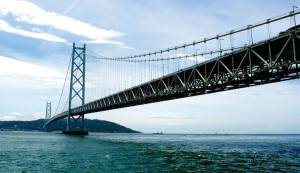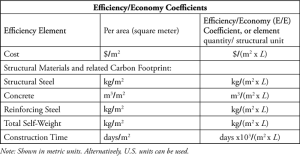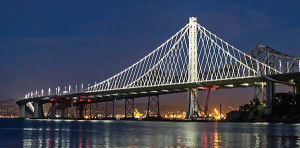Part 1: A Study for Structural Efficiency and Economy in Construction
Efficiency and economy of structures are important parts of structural engineering. This is not a new idea. Many remarkable bridges and buildings have been built under strict financial constraints.
The need for selecting an efficient structural system is valid for any structure, except some very rare cases when the owner possesses virtually unlimited funding and is more interested in building a monument than in efficient construction. In this 2-part article, more attention is given to bridge vs. building structures for two reasons: first, the cost of the structure in a bridge is the predominant part (about 90 to 98%) of the total cost, while for a building the structural cost is only about 12 to 18% of the total. Second, in bridges the structural engineer has much more influence on the final decision. However, further observations, data, and conclusions for bridge structures are also valid in general for building structures.
One can find discussions on the economy of materials and costs as early as the first century BC in Vitruvius, The Ten Books on Architecture, Book I, Chapter II. Although the well-known motto of Mies van der Rohe “Less is More” was intended for architecture, it is perfectly valid for any structure in terms of cost and materials. Later, in 1990, David Billington of Princeton University defined the three principles of good bridge design as Efficiency (of materials), Economy (of cost and time) and Elegance (slenderness, elegance, and good proportions).
It is even more important to have efficient construction in periods when a country’s economy is experiencing difficulty. In addition to new bridge construction resulting from increased demand, existing bridges are examples of an aging infrastructure not only in terms of years of service but also by falling behind the complex modernization of the transportation industry. The US Department of Transportation has found that at the end of 2015 more than 142,900 highway bridges in the country are structurally deficient or functionally obsolete. This is about 27% of all bridges (based on a percentage of their deck areas). The situation is even worse in some states. For example, in California, the deficient bridge area is 33.2%, in New York State, 58.9%! Despite the desire of political leaders to improve our infrastructure, the allocated funding will not suffice to repair or upgrade so many structures. Using efficient, economic structures is essential for better use of limited funding and for a faster improvement of the overall condition of the bridge infrastructure in this country. Also, environmental-best-practices, like using fewer materials in construction and reducing carbon footprints, place an increased importance on economics and efficiency.
Rating the Efficiency of Structures
To analyze structural economy, it is first necessary to determine how to rate and compare the efficiency of structures. The RS Means Construction Cost Data provides the cost range for different types of buildings around the country; however, these are average values for completed buildings and to the author’s knowledge there is no established normative for the efficiency of building and non-building structures. Designers, like owners and developers, are interested to know in advance the range of cost and material expenses needed to build a structure for a project of a certain magnitude, but such information is generally not available.
The main goal of efficient and economic design is to build a specific building, bridge or other structure for the lowest possible cost, with fewer construction materials while providing a high level of functionality and safety based on design criteria and code requirements.
The problem is the complexity of the task. For a single-family house, one measure is the cost per square foot. But even with this simple method, the task is very complex. The cost varies and depends on multiple program factors that include the built area, number of rooms and levels, macro and micro-geographic location, climate, nearby transportation, the proximity of good schools and stores, quality of construction and finish materials.
Similarly, estimating the cost of a bridge or other long-span structure is also very complex. It depends again on multiple project size factors: the structure’s usable area (defined as A, which is the total length, ∑L, multiplied by the usable width, B), length of structure span(s) L, height of structure above base level, seismic or hurricane prone areas, structural system, quantity and properties of used structural materials, country of construction (with its local material and labor cost, currency), year of construction, construction methods and technology (fabrication, transport and erection).
Usually, construction using less material should be more economical, but this is not always correct. Lighter but more complicated structures, while saving materials, may require more labor, therefore resulting in higher cost. Also important is the professional knowledge and information level of the owner, and the design and construction team, about available rational structural systems, and the team’s ability to select an appropriate efficient system.
For example, if a specific project site requires a bridge with a minimum main span of 1,312 feet (400m), there are only a few known systems that have already satisfied such spans: steel cantilever trusses, steel arches, cable-stayed and suspension bridges. The cantilever truss will likely be rejected as not being labor efficient. Unless an arch bridge is preferred from an aesthetic point of view, the most efficient and appropriate option will be either a cable-stayed or a suspension bridge, and the final selection will require further study based on these two systems.
In many cases, the selection of the most efficient system may be much more complicated. To select the most appropriate and efficient system, engineers need a sufficient database and established criteria to rate and compare different types of structural systems.
Very often in professional publications or in the jury’s comments for awarded projects, the structure is credited for its efficiency. Unfortunately, such a statement is rarely backed by technical and economic data, and it is almost never compared with other structural systems. Even more ironic, some of the highly awarded bridge projects are often among the least efficient.
It is time to establish criteria for structural efficiency that will allow professionals to estimate the achievement of a specific project objectively and to select solutions with less expensive structures. This requires assembling a large database for different structures – bridges, large span buildings, office buildings, tall buildings, etc. Such an informational base should be continuously expanded with new data contributions by design and building professionals, city and state building officials, and academia. This database is mainly needed for use by engineers and their clients in conceptual and preliminary design to help with the selection of the most appropriate and efficient structural system. It will also be an instrument for motivation and improvement toward more efficiency. The competition for improvement has always been a powerful tool for progress in engineering and in the development of society in general. Related to environmentally-friendly projects, the use of less material can reduce the carbon footprint and therefore works toward “saving the planet.”
Elements of Structural Efficiency
What is structural efficiency and economy? We usually consider a structure to be efficient and economical when it is built with fewer materials, for a lower cost and in a shorter time than an average structure of the same type and similar size. Therefore, the efficiency and economy of a structure can be measured by the construction cost, the quantities of main materials used, the weight of the finished product and the construction time per structural unit. A structural unit is defined as the product of the area covered by a specific structure times the average structural span (or the height for tall buildings).
The elements of efficiency and economy in structures include:
- Cost (total construction and “soft” costs)
- Main structural materials (structural steel and cables, concrete, reinforcing steel/stressing tendons)
- Total weight of the bridge or building, excluding foundations (and abutments)
- Construction time
The cost is supposed to incorporate all other elements and should have been sufficient for comparing the efficiency of structures if we had one universal currency used all around the world and the same local costs (for material and labor). However, this condition is not realistic. There are more elements of efficiency, such as the maintenance cost during the lifespan of the structure and the structure’s capability for future upgrade or modification. Although not a part of this article, detailed information on this subject can be found in Bridge Management by Bojidar Yanev.
David P. Billington’s main principles for good bridge design, efficiency, economy, and elegance are useful general directions, but they neither provide a specific normative for efficiency, nor for economy or elegance. While elegance could be a very subjective element, the efficiency coefficients for structures can be used as an objective measure of efficiency and economy.
The principle less is more (meaning better) is valid for all elements of efficiency. For example, the quantity of steel or concrete per unit area for a well-designed structure could be considered as a measure of the necessary material to build this specific structure. However, this is helpful only in comparing building or bridge structures with the same type of structure, with the same or very close range of spans. Every additional length added to the span (or to the height) increases the material quantity and the material per unit area. No valuable information is provided if one tries to compare, for example, the structural steel per square foot (ft2) of a 328-foot (100m) bridge span with the one used for a 3,281-foot (1000m) span. A simple approach to overcoming this difficulty is to use the “efficiency/economy coefficients” introduced in this article. These efficiency/economy coefficients (E/E coefficients) are determined by dividing the quantity of material, or the construction time, by the area times the average span of the structure, etc. The efficiency coefficients are shown in the Table.
The value of L is the span of a single-bay structure or the average span for structures of two or more spans. The efficiency/economy (E/E) coefficients are equal to the element quantity per square foot (or meter) divided by L, the average span of the structure, or in tall buildings, divided by the height (H) of the structure.
The general rule is that the smaller the E/E coefficient, the higher the efficiency of the structure. This is valid for all E/E coefficients – cost, materials, self-weight and construction time. Once the construction industry reaches a consensus about the equivalent carbon footprints for steel, concrete and timber structures, carbon footprint (or green) efficiency coefficients will probably play an additional important role in the rating of structures.
What do we expect from a structure? The most important requirement is that the structure shall provide sufficient strength to resist the code-prescribed forces from live loads and the natural elements (gravity, wind, earthquake, snow, ice), and shall have sufficient stiffness to keep the deformations below some established code limits. All structures shall be in compliance with these basic requirements as a given; therefore, the strength and stiffness are not considered further in this article.
The total self-weight coefficient is a simplified coefficient of performance (COP). The COP is the ratio of the design live loads versus the total self-weight of the completed construction. The larger the COP (larger ratio of live loads versus self-weight), the better, or more efficient, the structure. Because the live loads are prescribed by codes and are the same for a given type of structure (bridge or building), it is easier and simpler to compare the self-weight of completed projects directly. Put another way, the higher the total self-weight coefficient per the Table (i.e., the heavier the self-weight), the lower the efficiency of the structure. In its simplest form, a lighter structure supporting specific live loads is more efficient than a heavier structure supporting the same live loads.
It should be noted that a lighter structure means less steel or concrete, or both, and therefore a smaller carbon footprint. Using lighter structures better preserves the environment. Perhaps society will soon start prioritizing more projects built with fewer materials when this helps protect the environment, as the more complicated structures would require higher cost.
This article provides some basics for measuring the efficiency and economy of structures with the introduced Efficiency/Economy coefficients. Part 2, in an upcoming issue of STRUCTURE magazine, will provide tables with information on the efficiency and economy of bridges, bridge systems, construction time, and also efficiency and economy of long-span bridges and tall buildings. Part 2 also includes the author’s recommendations for further development of the database for efficiency and economy, and its use in engineering practice.▪
References
(Parts 1 and 2)
Vitruvius. The Ten Books on Architecture, Book I, Chapter II.
Billington, D. The Tower and the Bridge, Basic Books, Inc, New York, 1983.
Sobrino, J. A Bridge is More Than a Bridge: Aesthetics, Cost and Ethics in Bridge Design, SEI, 3/2013
Middlebrook, R. and Mladjov, R. San Francisco – Oakland Bay Bridge, STRUCTURE magazine, USA, 2/2014.
Mladjov, R. The Steel Structures, Sitius, Altius, Fortius, pp. 59 – 62; 113. Technica, Sofia, 1979.
Mladjov, R. The Super-Long Spans in Bridge Engineering. Construction, Sofia, 3/1988.
Mladjov, R. The Most Expensive Bridge in the World. Modern Steel Construction, USA, 9/2004.
Mladjov, R. Long-Span Bridges and the Art of American Bridge Engineering. SEAOC Conference, San Diego, CA,USA, 2009.
Yanev, B. Bridge Management. John Wiley & Sons, Hoboken, NJ, USA, 2007.
National Bridge Inventory, US Department of Transportation, December 31, 2014.



